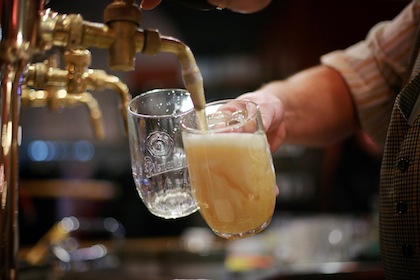It’s a sleepy Sunday lunchtime in Dobrany, a small town a few kilometres southwest of Pilsen. This is Bohemian beer country, deeply embedded in the lager lands of central Europe. Pivovar Modra Hvezda is a small brewery based in a comfortable hotel opposite the town square. A copper-faced brew-kit stands on show in the bar, though the real brewing action happens in the back. Meanwhile, in an ornately furnished dining room, brewmaster Petr Petruzalek, a tall serious-looking guy with a ponytail, is conducting a beer tasting.
Pilsner as a beer style might have crossed the world and spawned a thousand poor imitations, but as the example of the classic German pils demonstrates, not all are mere thirst-quenchers to be solely enjoyed on vacation.
Dobranska Desitka is the 10˚ unfiltered house lager, light orange-colored in the glass and sitting beneath a fine and firm head of snow-white foam. A nose of crushed grain (think Grape Nuts) with underlying hints of resin and ripe pineapple in the background leads through to an appetizingly crisp mouthfeel that is softened by a flurry of light sugary caramel notes before a dry, bittersweet finish. It’s marvelous.

(courtesy of Pilsner Urquell)
Dobranska Hvezda is the 12˚ svetly lezak (light lager), a superlative beer with sweet toasted grain, slight pepperiness and delicate Saaz-derived floral notes all vying for attention on the nose. The palate has a hint of fruit pastilles, a slight sweetness and a long lasting dry and bitter finish. A lightbulb flashes on in my head. I ask Petruzalek if what we are drinking is really a pilsner style, bearing in mind the closeness of the historical brewery (I didn’t know then that he had worked there until 2003). The answer, translated, comes back, “All these beers would be adjudged to be a pilsner style because of the way they are made.”
I guess he means yes. However, search through the rest of the Czech-brewing world and you will only find one brewery using the term pilsner: the mighty Pilsner Urquell, a Hercules of beer that has bestrode the world since its arrival in 1842. On that sunny afternoon, passing through this gorgeous array of beers, I wonder why this is so. Especially as in the rest of the brewing world the terms pils and pilsner/pilsener are sprinkled about as freely as ticker tape on a big day in Lower Manhattan.










Imperial Pilsner. What is it? Oh yeah, a stronger sort of pale lager. Hmmm? Where have I seen that? Wait a second! In Germany, and it’s called Helles Bock, and in the Czech Republic and it’s called Světlý Speciál! Stop “imperialising” and/or “doubling” things for effings sakes!
Good article otherwise.
Because SABMiller have such marketing clout this eurobeer, which is brewed in Russia and Poland as well, and tasted just the same, gets drank far to uncritically.
Pilsner simply means from Pilsen region and not long ago there were many such beers, but by closure or amalgamation the mighty SABMiller has crushed all that into its Eurokeg. Now some small “from pilsen” beers fight back.